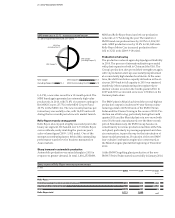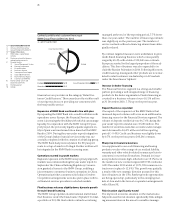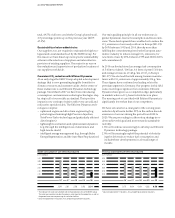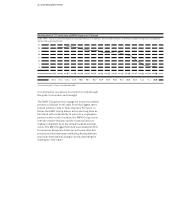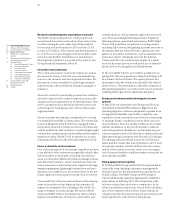BMW 2010 Annual Report Download - page 33
Download and view the complete annual report
Please find page 33 of the 2010 BMW annual report below. You can navigate through the pages in the report by either clicking on the pages listed below, or by using the keyword search tool below to find specific information within the annual report.31 GROUP MANAGEMENT REPORT
Implementing sustainable management throughout
the Group
Following on from 2009, when the BMW Group’s sustain-
ability strategy underwent further comprehensive devel-
opment, a number of measures and assessment criteria,
derived from groupwide strategic plans, were established
in 2010 for the various areas of management responsibil-
ity. Driving these measures was the objective of remain-
ing the most sustainable car manufacturer in the world.
This was achieved again in 2010 and confirmed by an in-
dependent source: the BMW Group remains the auto-
mobile sector leader for the sixth consecutive year in the
Dow Jones Sustainability Index family.
Our primary objective is to instil the concept of sustaina-
bility throughout the entire value-added chain and its
underlying processes. We will therefore continue to de-
velop our innovative drive train technologies and imple-
ment concepts for sustainable mobility in metropolitan
areas. At production level, we will continue to cut down
on the volume of resources used, reduce the impact that
production processes have on the environment and en-
deavour to include ecological and social requirements
inthe supply chain. Furthermore, we wish to remain an
attractive employer for our staff in the future. As an inte-
gral part of society, we will continue to be involved in
finding solutions for social challenges.
Sustainable management based on a “balanced score-
card” is a corporate objective which is now integrated in
processes throughout the BMW Group. Every project is
now required to be assessed in terms of this objective.
This involves measuring the consumption of resources,
emissions and also the social and socio-political impacts.
Key elements in our sustainability management are the
continual and systematic analysis of external develop-
ments, ongoing dialogue with our stakeholders and the
consideration of both social and ecological aspects when
making decisions.
A sustainability structure has been established to en-
sure
that our sustainability efforts are continuously man-
aged and further developed. At the highest level in the
Group is the Sustainability Board which makes all deci-
sions of strategic relevance. All members of the Board of
Management are automatically members of this board.
The Sustainability Circle, consisting of representatives
from the various divisions and headed by the Group
Officer for Sustainability and Environmental Protection,
is responsible for implementing sustainability activities
across the Group.
Clear targets for clean production
It is our intention to reduce the environmental impact of
production to the greatest extent possible. Items meas-
ured in this context include energy and water consump-
tion, process wastewater, solvent emissions and waste
fordisposal – expressed in terms of “waste per vehicle
produced”. We also measure carbon dioxide emissions
caused by the consumption of energy. The target is, by
2012, to reduce resource consumption and emissions
levels per vehicle produced by 30% compared with 2006.
Using an environmental efficiency figure as an indicator,
changes in resource consumption and emissions are
analysed across all items being measured. The environ-
mental efficiency figure for 2010 was improved by 6 per-
centage points during the period under report. The im-
provement since 2006 is 26%, surpassing the original
target of 20% set for 2010.
Energy consumption and emissions reduced
Total energy consumption in 2010 was reduced by
380,000 MWh and energy efficiency improved at the
same time. Energy consumed per vehicle produced in
2010 was 2.75 MWh (– 4.8%), in part helped by im-
proved capacity utilisation of equipment. As a result of
the lower amount of energy used in production, CO2
emissions were reduced by 74,700 tons. At 0.86 tons of
CO2 per vehicle produced, this was the equivalent of a
5.5% cut in emissions. Rigorous implementation of
savings measures is bringing us ever closer to our objec-
tive of improving energy efficiency by 30% between
2006 and 2012, in line with schedule.
Significant amounts of energy were saved through the
implementation of the “best practice” approach for inno-
vative production technologies. One example of this is
the new Integrated Paint Process (IPP) technology which
was initially developed at the Oxford plant and intro-
duced at the Spartanburg plant in 2010. The technology
ensures considerably lower environmental pollution and
higher productivity at the same time. After full conver-
sion, energy consumption in the paint shop will be re-
duced by 30%, CO2 emissions by 43% and solvent emis-
sions (VOC) by 7%. IPP has also reduced the processing
time per vehicle and will ultimately facilitate a produc-
tivity improvement of approximately 40%.
The aim is for each production site in the BMW Group
tobe powered by the most ecologically and economically
sustainable energy resource available. The US plant in
Spartanburg, for example, covers around 50% of its energy
needs using gas recovered from a nearby landfill site and


